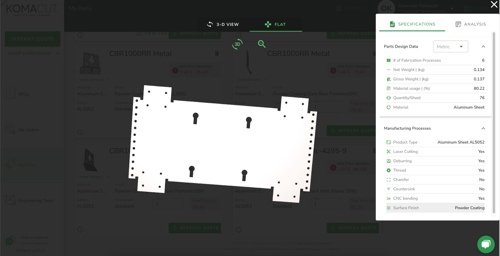Drawing Guidelines
We’ve prepared a short guide to the drawing formats you to use to quote parts on Komacut to get you started and making parts in no time.

What kind of drawing do I need to quote?
The type of drawing depends on the type of process or part you are buying.
- We require 3D drawings for some parts to ensure accuracy and the best price possible.
- Generally, we support 3D and 2D DXF drawings for most parts.
- For customers purchasing hardware or custom fastener kits, no drawings are needed.
| PROCESS | ACCEPTED DRAWINGS | ||
|---|---|---|---|
| 3D | 2D | VECTOR | |
| Laser Cutting | X | X | |
| CNC Sheet Metal Bending | X | ||
| CNC Turning | X | ||
| Hardware or Fasteners | |||
| Laser Engraving | X | ||
What kind of drawings do you accept?
Individual Parts
- All drawings need to be of a single, solid component.
- We don’t currently support quotation of multiple components.
- In case your drawing has multiple components, please save each part as their own drawing before uploading.
Supported Manufacturing Process
- Komacut currently offers laser cutting, bending, CNC turning and laser engraving for custom part manufacturing.
- Drawings which require stamping, punching, milling or other processes will be rejected by the platform.
- In case you have a part which requires a different production process, you can reach out to your account manager [hyperlink to service email] to discuss options.
3D Drawings

- What they are: a 3D model of the part that needs to be quoted and manufactured.
- What they’re needed for: We need 3D files to accurately nest, define bend angles and do all sorts of calculations for optimal part pricing and DFM analysis, and to manufacture certain types of parts.
- CNC sheet metal bending
- CNC turning
- Chamfers
- Milled features
- Requirements
- Sheet metal drawing design must be made using 3D sheet metal modules.
- 3D drawings must be of individual components, not assemblies
- 3D drawings must be in supported formats
- Supported Formats: We support a variety of standard 3D software formats, including:
- STP – File Extension: .stp
- STEP – File extension: .step
- Solidworks – File extension: .sldprt
2D Drawing Formats

- DXF Files
- What they are: an editable, 2D representation of the part to be manufactured.
- What they’re needed for: as a substitute for 3D drawings in cases where customers do not have, or to accompany 3D drawings of CNC machined parts.
- Laser cut or CNC bending parts quoted without 3D
- CNC turning parts – this is due to the tolerance and surface roughness requirements
- Requirements
- Must be a supported format (DXF)
- Must be supported software version (see below)
- DXFs should contain only flat pattern views. Any extra geometry, e.g. borders, another view, text converted to geometry extra will not work.
- Parts without bends (i.e. laser cut parts) can be exported without layer mapping, on any layer, except layer '3'.
- Drawings with bends will be rejected
- Supported Formats:
- DXF – file extension: .dxf
| Version | Autocad Release |
|---|---|
| AC1009 | AutoCAD R12 AutoCAD |
| AC1012 | R14 or RR2000 AutoCAD |
| AC1014 | R14 or RR2000 AutoCAD |
| AC1015 | R2000 |
| AC1018 | AutoCAD R2004 |
| AC1021 | AutoCAD R2007 |
| AC1024 | AutoCAD R2010 |
| AC1027 | AutoCAD R2013 |
Guidelines for Sheet Metal Bending DXFs

Part with bends should be exported using the given DXF layer map.
| Layer | Description |
|---|---|
| X Layer - 0F |
|
| X Layer 1F |
|
| X Layer 2F |
|
| X Layer 3F | Bounding Box layer |
| X Layer 4F | Sketches |
Different CAD software can have more or fewer options available for layer mapping. The option given above is available to most applications.
Layer mapping configuration files for Inventor and Solidworks are provided.
The following features/information cannot be currently recognized by our platform, so a 2D drawing would also be required for parts with:
- Countersinks
- Counterbores
- Threaded holes
- Bend angles (bends can be recognized but not bend angles)
- Blind holes
- Laser engraving
- Any machined/milled feature including but not limited to:
- Edge fillets
- Edge Chamfers
- Features requiring milling operations
Vector Files

- What they are: SVG vector images are composed of mathematical formulas that define the shapes in the image. This makes them scalable, so that they can be enlarged or reduced without losing quality.
- What they’re needed for:
- These are used for logos, icons, so any parts which have laser engraving to them
- Requirements
- Must be a supported format
- Supported Formats:
- SVG – file extension: .svg
